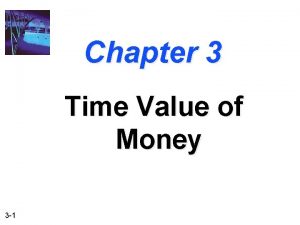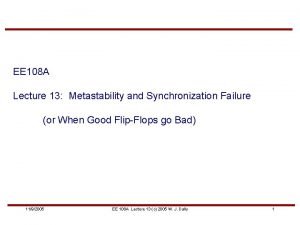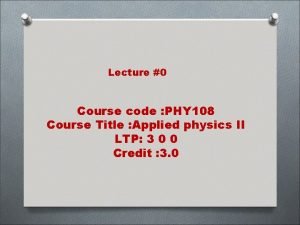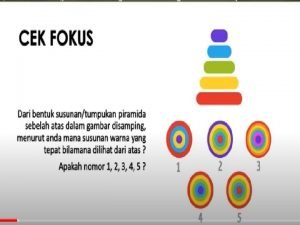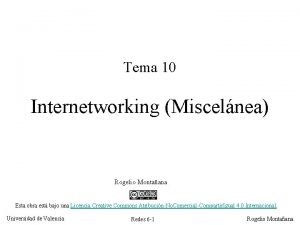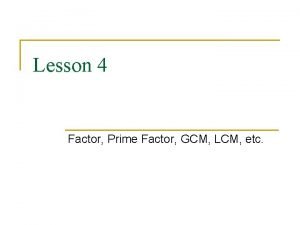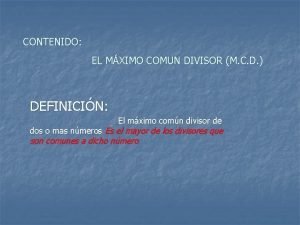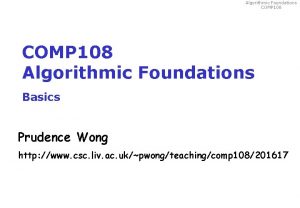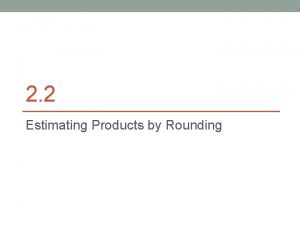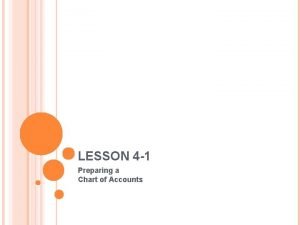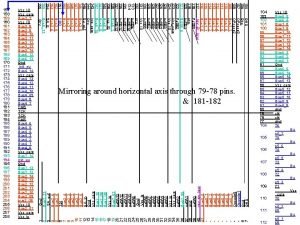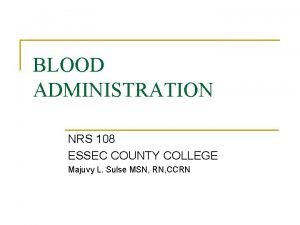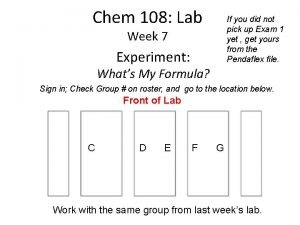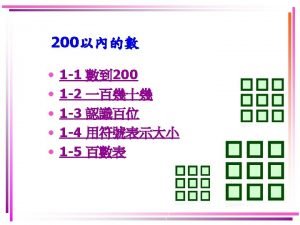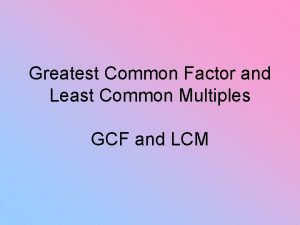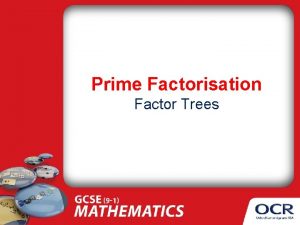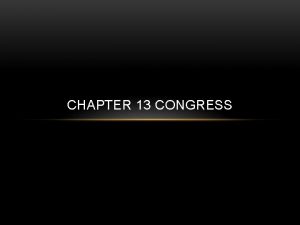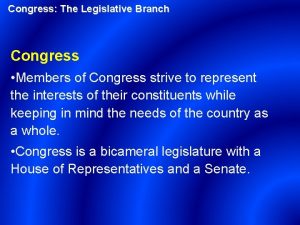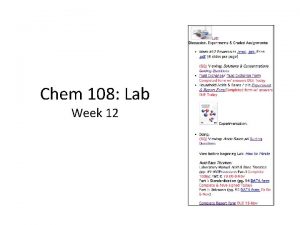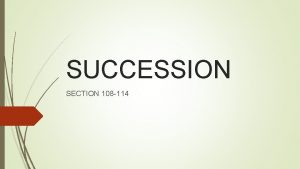The composition of the 108 th Congress is


































- Slides: 34

The composition of the 108 th Congress is 51 Republicans, 48 Democrats, and 1 Independent. A committee on aid to higher education is formed with 3 Senators to be chosen at random to head the committee. Find the probability that the group of 3 consists of… a) All Republicans b) All Democrats c) One Democrat, one Republican, and one Independent


Objectives: § Construct a probability distribution for a random variable. § Find the mean, variance, standard deviation, and expected value for a discrete random variable. § Find the exact probability for X successes in n trials of a binomial experiment. § Find the mean, variance, standard deviation for the variable of a binomial distribution. § Find the probabilities for outcomes of variables using the Poisson distribution.

Before we get started, let’s review some old vocab… 1. Variable – a characteristic or attribute that can assume different values. a) b) c) 2. Discrete variable – have finite number of possible values, or an infinite number of values that can be counted. a) 3. Various letters of the alphabet, such as X, Y, Z, are used to represent variables. Since the variables in this chapter are associated with probability, they are called random variables. Random variable – a variable whose values are determined by chance. Whole numbers Continuous variable – can assme all values in the interval between any two given values. a) Fractions, decimals.

§The outcomes when a die is rolled §The temperature throughout 4 hours §A person’s weight §The outcomes when you flip a coin

§ Discrete Probability Distribution – consists of the values a random variable can assume and the corresponding probabilities of the values. The probabilities are determined theoretically or by observation.

§Theoretical §Represent graphically the probability distribution for the sample space for tossing three coins.

§ Observational § The baseball teams playing in the World Series play until one team wins four times. This means there can be anywhere from 4 -7 games. Find the probability P(X) for each X, construct a probability distribution, and draw a graph for the data. X 4 Number of games played 8 5 7 6 9 7 16

§ The sum of the probabilities of all the events in the sample space must equal 1; that is, § The probability of each event in the sample space must be between or equal to 0 and 1; that is, 0 ≤ P(X) ≤ 1 ΣP(X) = 1

a) b) c) d) X 0 5 10 15 20 P(X) 1/5 1/5 1/5 X 1 2 3 4 P(X) 1/4 1/8 1/16 9/16 X 0 2 4 6 P(X) -1. 0 1. 5 0. 3 0. 2 X 2 3 7 P(X) 0. 5 0. 3 0. 4

§Suppose that 7 people enter a swim meet. Assuming that there are no ties, in how many ways could the gold, silver, and bronze medals be awards?

§We are familiar with finding mean, variance, and standard deviation. However, for probability distributions they are computed differently than they are for samples.

§ How would you compute the mean of the number of dots that show on top when a die is rolled? You could roll it, say, 10 times, recording the number of dots, and finding the mean; however the answer would only approximate the true mean. § To get an exact answer, we would have to roll the die an infinite number of times. Since this is impossible, we cannot use the old way to compute the mean.

§ Suppose two coins are tossed repeatedly, and the number of heads that occurred is recorded. What will be the mean of the number of heads? § What is the sample space? § What is the probability for each outcome in the sample space? § Probability of one head? § Probability of two heads? § Probability of no heads?


The mean of a random variable with a discrete probability distribution is μ = X 1 × P(X 1) + X 2 × P(X 2) + …. + Xn × P(Xn) μ = ΣX × P(X) where X 1, X 2, …, Xn are the outcomes and P(X 1), P(X 2), . . . P(Xn) are the corresponding probabilities. **Note: μ = ΣX × P(X) means to sum the products.

§ To find the variance for the random variable of a probability distribution, subtract theoretical mean from the each outcome and square the difference. Then multiply each difference by its corresponding probability and add the products. σ2 = Σ[(X – μ)2 × P(X)] However, this is tedious, so here’s a shortcut…

§ Find the variance of a probability distribution by multiplying the square of each outcome by its corresponding probability, summing the products, and subtracting the square of theoretical mean. σ2 = Σ[X 2 × P(X)] – μ 2 ****This is the shortcut. Use this one!**** § As always, the standard deviation is just the square root of the variance.

1. Find the mean, variance, and standard deviation of the number of dots that appear when a die is tossed. 2. A box contains 5 balls. Two are numbered 3, one is numbered 4, and two are numbered 5. The balls are mixed and one is selected at random. After a ball is selected, it is recorded and replaced. If the experiment is repeated many times, find the mean, variance, and standard deviation of the numbers on the balls.

3. A talk radio station has four telephone lines. If the host is unable to talk (i. e. during a commercial) or is talking to a person, the other called are placed on hold. When all lines are in use, others who are trying to call in get a busy signal. The probability that 0, 1, 2, 3, or 4 people will get through is shown in the distribution. Find the mean, variance, and standard deviation for the distribution. X 0 1 2 3 4 P(X) 0. 18 0. 34 0. 23 0. 21 0. 04 Should the station have considered getting more phone lines installed?

§ The expected value of a discrete random variable of a probability distribution is theoretical average of the variable. μ = E(X) = ΣX × P(X) § The symbol E(X) is used for the expected value. § The formula is the same as theoretical mean. § Expected value = Theoretical mean

1. One thousand tickets are sold at $1 each for a color television valued at $350. What is the expected value of the gain if you purchase one ticket? 2. One thousand tickets are sold at $1 each for four prizes of $100, $50, $25, and $10. After each prize drawing, the winning ticket is then returned to the pool of tickets. What is the expected value if you purchase one ticket?

3. A financial adviser suggests that his client select one of two types of bonds in which to invest $5, 000. Bond X pays a return of 4% and has a default rate of 2%. Bond Y has a 2. 5% return and a default rate of 1%. Find the expected rate of return and decide which bond would be a better investment. When the bond defaults, the investor loses all the investment.

§ 500 tickets are sold at $1 each for an i. Pad valued at $400. What is the expected value of the gain if you purchase one ticket?

§ Many types of probability problems have only two outcomes or can be reduced to two outcomes. § Coin toss § Winning or losing a game § Baby being male or female § True/false questions § Effective or ineffective medical treatment § Normal or abnormal blood pressure § Correct or incorrect answer

§ A binomial experiment is a probability experiment that satisfies the following four requirements: 1. 2. 3. 4. There must be a fixed number of trials. Each trial can only have two outcomes, or outcomes that can be reduced to two outcomes. These outcomes can be considered as success or failure. The outcomes of each trial must be independent of one another. The probability of a success must remain the same for each trial. § The outcomes of a binomial experiment and the corresponding probabilities of these outcomes are called a binomial distribution.

P(S) P(F) p q Probability of Success Probability of Failure Numerical Probability of Success Numerical Probability of Failure P(S) = p n X and P(F) = 1 – p = q Number of Trials Number of Successes in n Trials ***Note that 0 ≤ X ≤ n and X = 0, 1, 2, 3, …, n.

§ In a binomial experiment, the probability of exactly X successes in n trials is P(X) = n! (n – X)! X! × p. X × qn – X

A package contains 12 resistors, 3 of which are defective. If 4 are selected, find the probability of getting 1 defective resistor.

1. A coin is tossed 3 times. Find the probability of getting exactly 2 heads. 2. A survey found that one out of five Americans say he or she has visited a doctor in any given month. If 10 people are selected at random, find the probability that exactly 3 will have visited a doctor last month. 3. A survey from Teenage Research Unlimited found that 30% of teenage consumers receive their spending money from part-time jobs. If 5 teenagers are selected at random, find the probability that at least 3 of them will have part-time jobs.

4. Public Opinion reported that 5% of Americans are afraid of being alone in a house at night. If a random sample of 20 Americans is selected, find these probabilities by using the binomial table. a) There are exactly 5 people in the sample who are afraid of being alone at night. b) There at most 3 people in the sample who are afraid of being alone at night. c) There at least 3 people in the sample who are afraid of being alone at night.

§ Mean: §μ = n × p § Variance: § σ2 = n × p × q § Standard Deviation: § σ = sqrt(n × p × q)

1. A coin it tossed 4 times. Find the mean, variance, and standard deviation of the number of heads that will be obtained. 2. A die is rolled 360 times. Find the mean, variance, and standard deviation of the number of 4 s that will be rolled. 3. The Statistics Bulletin published by Metropolitan Life Insurance Co. reported that 2% of all American births result in twins. If a random sample of 8, 000 births is taken, find the mean, variance, and standard deviation of the number of births that would result in twins.

 Obtuse
Obtuse Pvifa
Pvifa Multibit synchronizing
Multibit synchronizing Phy 108
Phy 108 Edmonton mental health clinic 108 street
Edmonton mental health clinic 108 street Gianni schicchi divina commedia
Gianni schicchi divina commedia Hasil dari 108+132-134 adalah
Hasil dari 108+132-134 adalah 192,168,1,108
192,168,1,108 Corso toscana 108
Corso toscana 108 Engineering 108.com
Engineering 108.com Gcf meaning
Gcf meaning 108 mangalasasana divya desams
108 mangalasasana divya desams Convention 108 data protection
Convention 108 data protection Mcd definicion
Mcd definicion Factors of 108
Factors of 108 Lesson 108
Lesson 108 Round the factors and estimate the products exit ticket
Round the factors and estimate the products exit ticket 4-2 work together p. 108 answers
4-2 work together p. 108 answers Didžiausia planeta
Didžiausia planeta Hcf of 4 and 9
Hcf of 4 and 9 200 to 300 prime numbers
200 to 300 prime numbers 107 108 109
107 108 109 Nrs 108
Nrs 108 108 lab
108 lab Sura 108
Sura 108 Mesohippus
Mesohippus 101 102 103 104 105 106 107 108 109 110
101 102 103 104 105 106 107 108 109 110 What is the prime factorization of 80 using exponents
What is the prime factorization of 80 using exponents 466560/108
466560/108 108 diğer hazır değerler kredi kartı
108 diğer hazır değerler kredi kartı Gcf of 54 and 72
Gcf of 54 and 72 108 semester
108 semester 56 as a product of prime factors
56 as a product of prime factors 108 x 300
108 x 300 Engineering 108.com
Engineering 108.com

